CES 2013: Looking beyond 4k to the TVs of the future
- Published
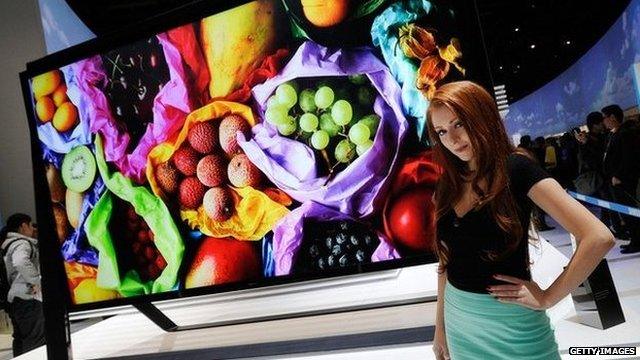
Record-sized LCD displays are on show at CES to best show off 4k's resolution
Screens with 33-megapixel resolutions, projectors that blend their output to go as large as you want and screenless displays hint at the future of TV at CES.
New TV tech has always been at the heart of the Consumer Electronics Show.
The focus of last year's event was smart TV interfaces, but attention has swung back to the screens themselves this year with Sony and others declaring 4k's time has come. The term "4K" refers to the horizontal resolution of such screens as they are all about 4,000 pixels in width.
Also known as "ultra-high definition", the format offers four times the resolution of the current 1080p HD standard and is best appreciated up close, or further away from a mega-sized screen.
There is a deluge of 4k displays on the show floor - some adding OLED (organic light-emitting diode) tech to offer richer colours, others slimming the screen's bezel down until it is almost not there. Samsung and China's HiSense have also made a splash by exhibiting sets with gargantuan 110in (279cm) images.
But the truth none of the manufacturers likes to talk about is that the challenge involved in packing so many pixels into a small space means their prices are likely to stay too high for most for a while longer.
Beyond 4k
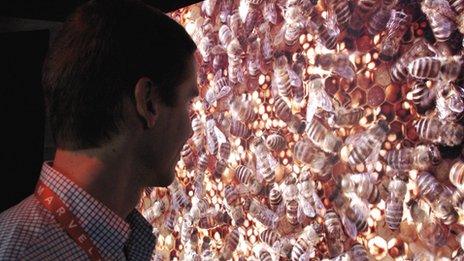
Sharp's prototype 8k screen was best appreciated close up
So let's switch focus and explore what the next next-generation displays might be.
The most obvious bet can be found at Sharp's stall, where an 8k screen is on show. The 85-incher (216cm) offers more detail than a 33-megapixel photo. By contrast 1080p offers about 2MP.
Sitting at the back of a room our eyes simply aren't sophisticated enough to spot the difference, but close up the effect is startling. There's a real sense of depth without needing other 3D tech.
But bearing in mind most of us don't watch TV with our face centimetres away from our flatscreen, why bother?
"If 4k is the next great thing, then you can divide your screen into four sections and run simultaneous football games in full resolution on your 8k television," Sharp spokesman Brad Lyons says. "That has applications in bars."
Surgeons, he adds, would benefit from using TV equipment that can show up minute details hidden by current tech.
See-through TV
Samsung and LG' stalls have another hint of what's to come - the world's first curved OLED screens.

Samsung's Transparent Showcase
They're not quite the bendy TVs some had predicted, but the firms say the innovation should improve viewing angles.
Perhaps more exciting is a product that has just made it to market. Samsung's 22in (56cm) Transparent Showcase is a glass box big enough to contain a product - shoes in this case - that lets retailers float video promotions over the front panel.
Then at the end of the day, when unplugged, the glass turns black.
It hints at a time when TVs might be used as augmented reality devices, providing information about objects placed behind them.
"All LCDs are transparent anyway - they're a piece of glass," explains Don Hickey, Samsung's solutions architect for large format displays.
"We've just moved the electronics to get them out of the way.
"Going forward [larger versions] could be used in schools as a show-and-tell type of device... and it could be used at trade shows."
In the meantime HiSense also has a transparent 3D TV on show which it says should go on sale later this year.
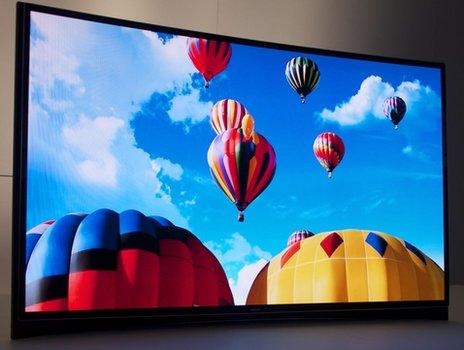
The first curved OLED TVs were on show proving TVs don't have to be flat
Projected pictures
A new product from LG suggests that the focus of future TV development might not be about screen tech at all.
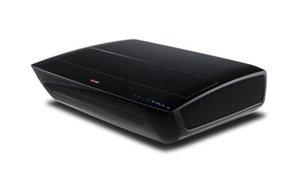
LG's projector can be placed within arm's reach of its screen
It has unveiled Hecto - a laser projector which creates a 100in image when placed on the floor just 22in (56cm) away from a blank panel. One benefit is that video gamers and other viewers wanting to be close to the action can stand close to the picture without worrying about casting a shadow.
"We use lasers for brightness so it can be seen in a light environment," adds Malik Davis-Bey, the man responsible for showing it off at CES.
At $19,999 (£12,485) it's a lot to pay for an 1080p image whose colours are less vibrant than those of an LCD. But it's first generation and the technology is sure to improve.
Choose-your-own size
For those who don't mind dimming the lights and closing the blinds, Vivitek offers a cheaper projector that sits a mere 15.4in (39cm) away from the wall.
The Taiwanese firm's kit has the added benefit that projectors can be combined to create a display of whatever size or aspect ratio you prefer.
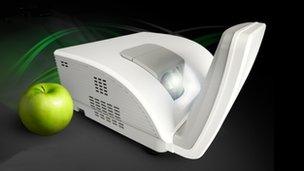
Vivitek's projector can be combined to create different sized screens
"You install the projectors and their images overlap 10 to 20%," explains Holger Graeff, the firm's general manager for Europe.
"Then a camera looks at the entire screen and the software blends all the images to create one big monitor."
Mr Graeff adds that projected technologies hold the promise of even more advanced features down the line.
"[There will be] holographic applications like in Star Wars where you have your image projected in 3D and you can walk around it," he exclaims.
"But it will take quite some time before that is viable in the home."
Water TV
The challenges of making a screenless display hasn't stopped one Russian start-up from trying.
Displair is showing a system at CES which uses a humidifier to create a curtain of air made out of tiny water particles that feels dry to the touch, but is substantial enough to project an image on to.
It's even interactive - built-in cameras and software algorithms analyse your hand movements so that you can manipulate the image.
Volunteers have been able to use it to play Fruit Ninja, karate chopping the video game's virtual pineapples and bananas in half.

Displair's screen adapts a humidifier to create an image in mid-air
The prototype's image quality isn't good enough to watch a show or movie on it at this point - but the firm says it will improve, adding that there are benefits beyond being able to mimic Tom Cruise in Minority Report.
"It's a greener option," says spokeswoman Kim Terca.
"Right now electronics make up a huge percentage of landfill waste. It doesn't make sense to make these glass and metal boxes that get used and then thrown away with all their lead and other toxic materials."
She adds that a spin-off benefit is that the moisture used is good for your skin.
So, 8k holographic humidifiers by 2023? Stranger things have happened at CES.